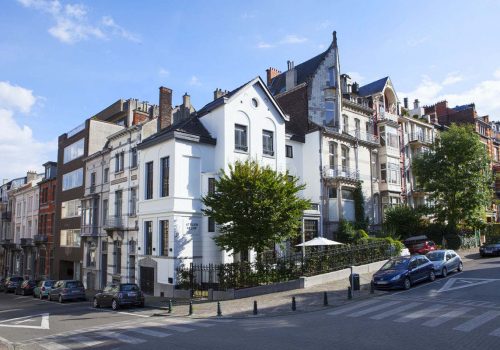In Brussels, a workshop lends added depth to photography. Created in 2015, the Atelier Relief has collaborated with photographers and architects to create three-dimensional photographic tableaus where image gains depth, appears in relief, and acquires materiality and volume. The visit takes us to the Brussels district of Ixelles, to the Atelier’s home of creation and production.
The Atelier Relief was created in 2015. It is the fruit of a personal initiative that slowly developed over the course of ten years of reflection, interviews, and encounters. Let’s step back ten years. In Montreal, the future founder of the Atelier Relief, Farid Issa, is decorating his mantle. He is holding a photographic print and begins to cut it up, deconstructing the image and then reassembling it using a system of raised supports. Simple in execution, the idea produces a wonderful result. Ten years go by. During this time, Farid Issa left his job, went back to school to study literature in Lausanne, and began discussing the idea with photographers. The concept gradually took shape and, quite accidentally, came to fruition in Brussels. The city enjoys affordable rents and a vibrant artistic, and especially photography, scene.
In about three years, the Atelier Relief has produced about 150 to 200 works. It has brought together numerous photographers and artists, including, most recently, the Austrian portraitist David Uzochukwu and the Flemish artist Karel Fonteyne. Setting photography in relief offers nearly limitless potential. Whether for architecture, fashion, photojournalism, or portrait photography, it can always be dismantled and then put back together in a different way. The cuts are first prepared using Sketchup, 3D design software; then the production team uses a CNC digital cutter, a laser cutter, or water-jet cutting. It makes no difference if the print is mounted on wood, metal, paper, or plastic: nothing resists for long. Finally comes the lengthy work of mounting the image on supports, sort of short pillars made of wood or metal, which give the picture its material quality.
Triple Turn by Dirk Bakker is a good example. The Amsterdam photographer is interested in contemporary architecture, in stacked housing blocks rising into the sky, in their concrete brutality. In this case, the setting in relief involves playing with the reality of the image. The two towers are twisted, coiling round their axis, infusing a static image with rhythm.
We encounter a similar idea in Olivier Truyman’s Hong Kong III. A surcharged apartment building, captured in mid-section, seems fractured by a fissure imagined by the Atelier. A powerful, immersive picture has thus been exploded, and the split suggests that the building is about to collapse. Through its materialization, the image is infused with humor as much as with drama.
In the words of Farid Issa, the primary goal of the Atelier Relief is to “restore to the image its intrinsic dimensionality.” Karel Fonteyne’s The 12th Box is entirely a found object. The cutting and materialization performed by the Atelier Relief have opened up certain cubic elements against a golden background. The added depth reinforces the enigmatic character of the image, opening it up in the direction of surrealism even while playing with spaces and volumes captured by the photographer.
At the Brussels Photo Festival, the Atelier presents its latest exhibition, Portrait. The exhibition shows the most recent creations of the firm. The Atelier Relief will be featured at the upcoming MIA festival in Milan before, perhaps, “elevating photography” in other parts of the world.
Arthur Dayras
Arthur Dayras is a writer specializing in photography. He lives and works in Paris.
















